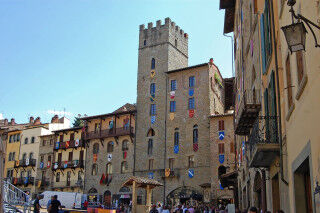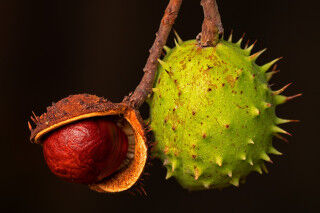Most tourists heading for Tuscany visit Florence, Siena, or Pisa. But Tuscany has lots more to offer than just the big names: smaller, less well-known towns can show you a different side of Tuscan life while expressing their own individual characters.
Lucca, a lovely cathedral city on the plains of the Arno valley, is still surrounded by its high defensive walls. The city is a treasure trove of Romanesque art; the cathedral contains the Volto Santo, an ancient crucifix that drew pilgrims from all over Italy, while San Frediano has a massive carved font showing the story of Moses. Winding streets of old houses in pale orange and pink end in towering white marble church facades, and the massive brick Tower of the Guinigi family dominates the east of the city.
Barga is a short bus ride away from Lucca, but you couldn’t imagine a more different town. Located in the foothills of the Apuan Alps, its streets are steep and narrow as they run upwards to the gleaming white church. Barga’s traditional foods come from the mountains nearby, featuring delicious seasonal specialties like chestnuts, wild boar, and forest mushrooms. Even with a shining sun, the city stays cooler compared to the cities of the plain below.
Another city with rough edges is Volterra, which feels like Tuscany’s Wild West thanks to a dramatic rocky-ridge location overlooking the untamed, arid landscape below. Etruscans operated mines here, and with a planned visit to the nearby Guarnacci Etruscan Museum, you can see firsthand prime examples of their metalwork, as well as a large collection of funerary urns, with vivid portraits of the deceased. In keeping with Volterra’s outlaw-like feel, its fine Renaissance fortress became a state prison, with a pleasant surprise for visitors. The prison also hosts a highly-rated restaurant where the cooks and waiters are all prisoners. Bookings must be made well in advance and there are strict security checks during your stay.
Another charming hilltop town in Tuscany shares Etruscan roots with Volterra. With Etruscan tombs surrounding the city, Chiusi is also famous for their underground tunnel system, known as The Labyrinth, which were actually excavated by the Etruscans for drainage purposes.
Monteriggioni, close to Siena, is perhaps the most shining example of a traditional walled Tuscan hilltop town, with its majestic walls and towers dominating the valley below. Inside the town, it’s little more than a village, with attractive gardens and elegant Renaissance houses.
If its towers you want, visit San Gimignano. The city’s Medieval noble families feuded perpetually, and each family built its own fortress; fourteen of the towers still survive. The town’s main church has Renaissance frescoes, and there’s a good gallery of Renaissance paintings. Wine lovers will want to track down the local Vernaccia wine. A crisp, dry white wine perfectly expressing the Tuscan countryside with its subtle aromatic herbs infusing the landscapes.
Further south, in an area little known by tourists, Pitigliano and Sovana are two ancient towns linked by an Etruscan chariot route which can still be followed across the plateau. Pitigliano, built with creamy local stones above the valley of the Fiora, is known as Tuscany's Jerusalem, since it was a refuge for Jews fleeing persecution in the Papal States. While the Jewish population is much diminished today, the synagogue is open to visitors looking to connect with this ancient past. Many houses in Pitigliano have wine cellars that were dug by the Etruscans, while Sovana has well preserved Etruscan tombs.
An unusually complete Renaissance town is Pienza, named after its founder, Pope Pius II. It is a logically-planned town, focused on its main square with gorgeous cathedral. Also certainly worth visiting is the pope’s family palace, the town hall, and the bishop’s palace, each one occupying one side of the square. The architecture’s style is pure and delicate, and the whole town seems to be a perfect miniature of the ideal Renaissance town.
Cortona shows a different side of the Renaissance with paintings by Fra Angelico, and two elegant Renaissance churches. The town is classically Medieval with its steep, narrow streets and tall houses perched on a steep hillside. Medieval customs thrive here, with an annual archery contest held each June, and stunningly evocative historic processions in Medieval costume in May.
Florence may be a honey pot for culture vultures, but Tuscany's smaller towns can offer just as many interesting cultural experiences, in a more relaxed and less crowded atmosphere.









